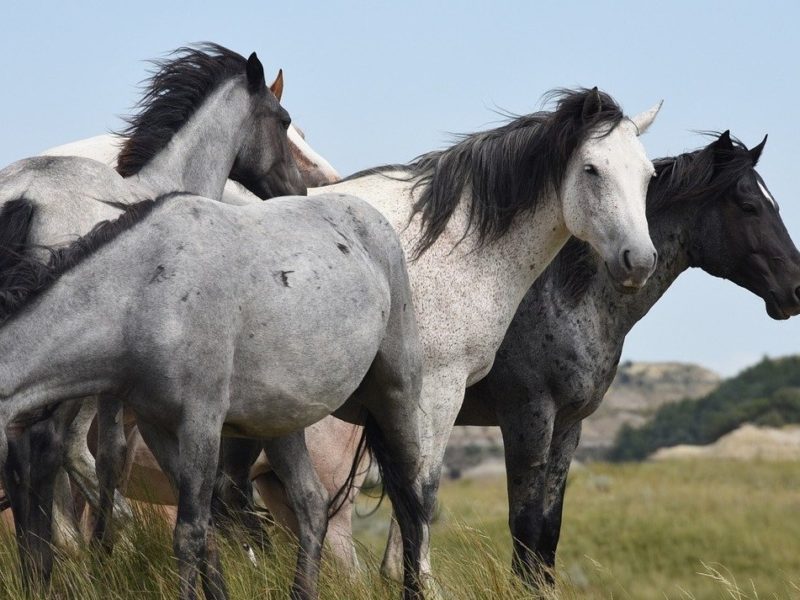In the creation account of Genesis 1, a Hebrew phrase is used when describing the creation of plants and animals that is not used in describing anything else in His creation. The phrase occurs ten times in Genesis 1 and translates into English as ‘according to their kind’1. God commanded the earth to produce fruit trees ‘according to their kind’ and the earth brought forth herbs and fruit trees ‘according to their kind’ (Gen. 1:11-12). God created every living creature in the water and in the air ‘according to their kind’ (Gen. 1:21). God commanded the earth to bring forth living creatures of the land ‘according to their kind’, and God made the beast of the earth, the cattle, and every creeping thing ‘according to their kind’ (Gen. 1:24-25).
The following article is an excerpt from Devotional Biology: Learning to Worship the Creator of Organisms, Ch. 4.1, pgs. 85-86. The views expressed in this article reflect those of the author, and not necessarily those of New Creation.
Later in the biblical account, God commands Noah to take birds, cattle and every creeping thing onto the ark ‘according to their kind’ (Gen. 6:19-20), and every bird, every beast, all cattle, and every creeping thing entered the ark ‘according to their kind’ (Gen. 7:13-14). Finally, at the end of the Flood, every beast, every creeping thing, and every bird exited the ark ‘according to their kind’ (Gen. 8:18-19). Later yet, humans were told to eat and not eat specific organisms ‘according to their kind’ (Lev. 11:14-16, 19, 22, 29; Deu. 14:13-15, 18).
Linguistically, considered alone outside of its larger context, it is possible that the Hebrew phrase merely refers to a diversity of things. In other words, ‘God created birds according to their kind’ might be translated ‘God created a number of different birds’ or ‘God created a variety of birds’ or ‘God created a diversity of birds’. However, the specific way in which the phrase is used in Scripture suggests there is more to it than a mere statement of diversity.
First, since the biblical phrase ‘according to their kind’ is only used in reference to organisms, ‘kind’ appears to be something biological. Second, the fact that Noah is to take two of every ‘kind’ onto the ark (Gen. 6:19-20) suggests that a ‘kind’ is a group with more than one member. Putting these two deductions together, a ‘kind’ appears to be a group of organisms. Third, Genesis 2:19-20 indicates that Adam named all the ‘beasts of the field’ and the ‘fowl of the air’, and this occurs between the creation of Adam (Gen. 2:7) and the creation of Eve (Gen. 2:22).
Since the creation of both Adam and Eve occurred on the sixth day of creation (Gen. 1:23-31), Adam must have named all these animals on a single day. Getting all this naming done in a portion of one day suggests that Adam named animals rapidly. Considering also that Adam’s names were accepted without question by humans following him (Gen. 2:19), suggests that Adam named these animals in some sort of natural or intuitive manner.
All this suggests that God created organisms in groups (‘kinds’) and created humans in such a way that they can recognize those ‘kinds’. That humans have the intuition necessary to recognize ‘kinds’ would also explain how Noah could follow God’s command to permit pairs of each ‘kind’ onto the ark (Gen. 6:19-20), and how after the Flood, the Israelites could choose the right organisms to eat and not eat ‘according to their kind’ (Lev. 11:14-16, 19, 22, 29; Deu. 14:13-15, 18).
From the third deduction about ‘kinds’—their recognizability—flow two other deductions (a fourth and a fifth). For a ‘kind’ to be recognizable there must be similarity within the ‘kind’ (the fourth deduction) and dissimilarity between the ‘kinds’ (the fifth deduction). To correctly identify all members of a ‘kind’ they must all be similar to each other—or at least have in common one or more noteworthy features.

At the same time, to make sure that no member of another ‘kind’ was mistakenly identified as part of any given ‘kind’ there needs to be substantial difference or differences between each ‘kind’ and every other ‘kind’. Described another way, the ‘kinds’ are separated by gaps. The fact that each of Adam’s names ‘became the name’ thereafter (Gen. 2:19) leads to a sixth deduction—that each ‘kind’ remained the same for generations to follow Adam. And, given that most of the pre-Flood patriarchs lived into their tenth century (Genesis 5), it follows, then, that ‘kinds’ must persist for at least thousands of years.
A seventh deduction is derived from the creation of organisms ‘according to their kinds’ on three different days of the Creation Week: each biblical ‘kind’ was separately created. Combined with the distinction and persistence of ‘kinds’, it seems reasonable to conclude that the ‘kinds’ remained distinct from each other up until the Flood. At the time of the Flood, the animal ‘kinds’ were taken ‘two by two’ onto the ark so as ‘to keep them alive’ (Gen. 6:19-20), ‘multiply on the earth’ (Gen. 8:17) and persist for ‘perpetual generations’ (Gen. (9:12).
From this we derive our final (eighth and ninth) deductions. The eighth is that each biblical ‘kind’ was created to remain distinct for all of earth history, so that the gaps between ‘kinds’ are too broad to cross—or, at the very least, have never been crossed. Every ‘kind’ is therefore surrounded by a discontinuity that cannot be (or has not been) crossed—what might be called a deep discontinuity. The last (ninth) deduction is that members of a ‘kind’ have the capacity to breed with one another and produce other members of the ‘kind’ for successive generations, but probably lack the capacity to breed with other ‘kinds’. Although interbreeding may be possible among some or many members of a ‘kind’, it may not be possible between members of two different ‘kinds’.
Combining all nine of our deductions, Scripture’s use of ‘kind’ suggests that organisms should be classifiable into ‘created kinds’—with each ‘kind’ being a recognizable group of similar organisms which is surrounded by deep discontinuity and persists by members interbreeding and producing similar offspring.
[A created kind is] a recognizable group of similar organisms which is surrounded by deep discontinuity and persists by members interbreeding and producing similar offspring.
– Kurt Wise
Adam’s names were probably consistently used as long as there was a single human language. After the confusion of tongues at Babel, however, it is likely that each language ended up with different names for the same organisms. Even within the various language groups, individual tribes and families over the millennia invented their own names for organisms.
By the middle of the eighteenth-century A.D. many, many thousand names existed for organisms. In fact, too many names existed. In many cases a particular organism had lots of names, making the study and understanding of the organisms of the world a bit challenging. Carl Nilsson Linnaeus (1707-1778) determined to standardize the naming of organisms. Since he believed in the concept of the biblical ‘created kind’, Linnaeus sought to assign each ‘kind’ a single, standard name that would be used by biologists all over the world. He created names in Latin, the standard language of the former Roman Empire (and a substantial fraction of the known world).

Linnaeus recognized that different people consistently united organisms into the same groups, or taxa (sing. taxon). The fact that such taxa were consistently identified by very different people suggested that the groups were recognizable by humans—just as was expected of biblical ‘kinds’. Members of these taxa were also observed to be ‘interbreeding and producing similar offspring’—a second thing expected of biblical ‘kinds’. Finally, in Latin, these taxa were called species, and species was the Latin translation for the Hebrew word mîn in the Vulgate (the Latin Bible)!
This suggested that species really were the biblical ‘kinds’. Fulfilling as they did, many of the requirements of biblical ‘kinds’, Linnaeus began his naming task with the conviction that species were to be equated with ‘kinds’. Because he thought biblical ‘kinds’ could not change and could not interbreed, Linnaeus began his career believing that species could not change, and that members of two different species could not possibly interbreed.
As Linnaeus began to name hundreds, and then thousands of species2, he discovered organisms he believed to be hybrids between two different species (inter-specific hybrids). As a result, Linnaeus revised his hypothesis that species were biblical ‘kinds’ and began to believe that the ‘kind’ was a larger grouping than the species. At first Linnaeus theorized that the ‘kind’ was to be equated with the ‘genus’, a biological taxon which contains one or more species. In the nearly quarter of a millennium that has elapsed since Linnaeus, Linnaeus’ suspicion has been verified in three different ways. First, many of the species of the world have been shown to produce inter-specific hybrids3. Second, some pairs of species that occupy adjacent tracts of land have a hybrid zone between them—a zone at the boundary where members of the two species naturally interbreed and produce intermediates between the two species. Third, a small percentage4 of pairs of fossil species have ‘populations’5 of stratomorphic intermediates between them. These are groups of fossils that are younger than one species and older than the other6 and have a body shape intermediate between the two species7. Stratomorphic intermediate ‘populations’ between two species appear to record the transformation of the older species into the younger one. It seems, then, that the biblical ‘kind’ must be a larger grouping than the species, just as Linnaeus surmised nearly two hundred and fifty years ago.

As Linnaeus continued to name organisms, however, he eventually discovered organisms he believed to be inter-generic hybrids (hybrids between different genera). This led Linnaeus to theorize that the biblical ‘kind’ was an even larger group than the genus. Since the time of Linnaeus this inference has also been confirmed. Though not as common as inter-specific hybrids, a large number of inter-generic hybrids are known. Many orchids used in corsages, for example, are inter-generic hybrids8.
However, whereas hybrid zones are known between different species, no hybrid zones are known between different genera. And, whereas ‘populations’ of stratomorphic intermediates are known between fossil species, ‘populations’ of stratomorphic intermediates are not known between fossil genera. Yet, fossil genera themselves can be arranged into a stratomorphic series. This is a sequence (or series) of fossil genera found in successive layers that step through a sequence (or series) of forms, rather analogous to footprints in a trackway through time. For example, successive horse genera in Tertiary and Quaternary rocks of North America step through a sequence of increasing size, decreasing number of toes, and increasing tooth height.
There seems to be considerable evidence, then, that the biblical ‘kind’ is a larger grouping than the genus, just as Linnaeus surmised in the latter part of his life.In the last part of his life Linnaeus believed that the created ‘kind’ was equated with the taxonomic9 ‘family’—a biological taxon which contains at least one genus. Linnaeus died believing that taxonomic families do not change and members of one taxonomic family cannot interbreed with members of any other taxonomic families. In the last quarter millennium, evidence has accumulated to confirm Linnaeus’ last inference as well. No hybrids have been discovered between members of different taxonomic families, no hybrid zones are known between living taxonomic families, no stratomorphic intermediate ‘populations’ are known between fossil taxonomic families, and no stratomorphic series are known made up of fossil taxonomic families.
Because many taxonomic families seem to be separated by the sort of non-traversable gaps (deep discontinuity) expected between biblical ‘kinds’, some creationists have suggested that the biblical ‘kind’ should be equated with the taxonomic family, just as Linnaeus died believing. However, there are some cases where deep discontinuity seems to exist below the level of the taxonomic family and other cases where deep discontinuity cannot be found until the group is larger than the taxonomic family. More study is needed to clarify exactly how the biblical ‘kind’ relates to the groupings that biologists have created over the centuries.
In the meantime, creation biologists think it is best to identify the created ‘kinds’ independently of the biological groupings created by Linnaeus and other taxonomists. Furthermore, to avoid the confusion that might come from using the word ‘kind’—a term already having a variety of common meanings—many creationists refer to the ‘biblical kind’ as a baramin (Hebrew: bâra, ‘to create’ + mîn, ‘kind’)10.
Footnotes
- According to’ can be replaced with ‘after’. ‘Their’ can be replaced with ‘its’ or ‘his’. ↩︎
- Plant species, as they were Linnaeus’ specialty. ↩︎
- Some of these hybrids are formed under natural conditions. Others are formed ‘artificially’, meaning either they produce offspring by natural means, when members of one or both species are taken from where they live naturally and placed together, or humans mix the genetic material of the two species. ↩︎
- Something less than 1% of fossil species. ↩︎
- Technically, populations are groups of interbreeding organisms. Technically, since it is impossible to determine if fossil organisms could actually interbreed, fossil populations are impossible to demonstrate—thus the quote marks around ‘population’ when referring to fossils. ↩︎
- I.e. stratigraphic intermediates—in other words, located in intermediate or in-between strata (where ‘strata’ are rock layers) ↩︎
- I.e. morphological intermediates—in other words, having an intermediate morphology (where ‘morphology’ refers to the ‘morph’ or form of an organism) ↩︎
- Some of the most popular corsage orchids are the Rhyncholaeliocattleya orchids, produced by crossing the genera Rhyncholaelia, Laelia, and Cattleya. The Gladysyeeara orchid is another type of orchid hybrid produced by crossing 8 genera (Brassavola, Broughtonia, Cattleya, Cattleyopsis, Caularthron, Epidendrum, Laelia, and Sophronitis)! ↩︎
- So as not to confuse the word ‘family’ as it is used here with the more familiar meanings of family (e.g. human parents and children), the somewhat awkward term ‘taxonomic family’ will be used in the text. Taxonomy is the science of naming organisms—the very thing Linnaeus was doing. The ‘family’ to which we are referring is one of the groupings of organisms that taxonomy identifies and names—thus why it is called a ‘taxonomic’ family. ↩︎
- ‘Baramin’ was coined by Frank Lewis Marsh (1899-1992) in 1941. ↩︎
The author, Dr. Kurt Wise, has graciously granted New Creation permission to publish selected sections from Devotional Biology: Learning to Worship the Creator of Organisms. To purchase a copy, please visit our online store.












I clearly understand your motivation but this makes communication about taxonomic issues with non-creationists virtually impossible.